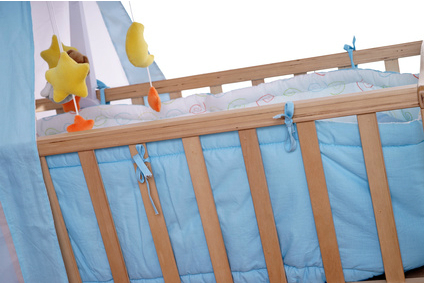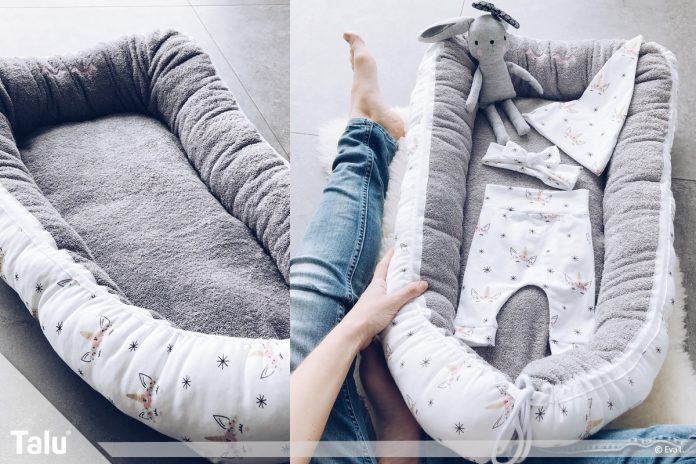Baby cribs have long been a hotly debated topic between experts and concerned parents. Some mothers and fathers find a soberly furnished bed without pillows, blankets and a whole parade of cuddly toys to be cold and uncomfortable.
However, experts in health issues advise precisely this exaggerated coziness as it may endanger the newborn.

But what exactly is this danger? Is there really only a strict solution to the dilemma, or can worried parents answer this question a golden middle ground for themselves and their offspring?
We want to try to get to the bottom of these questions and potential dangers in order to show possible arguments when deciding for or against a nest in the baby bed. But first, what exactly is meant by a nest:
What is a "baby crib nest"??
Nests are mainly known from the great outdoors and from biology classes, where they are mainly associated with birds who build their homes from small branches and other materials high up in the trees.
Of course, that’s not how it works for us humans. What the general public likes to call a nest or bed nest is in most cases a structure made of pillows or thin mats covered with fabric, which is attached to the bars of the baby bed and frames the headboard and a piece of the side walls. For this reason, it is often referred to as a bed surround. With a nest in the baby bed or bassinet, that should Feeling of security and coziness are conveyed – just like in a real nest. In addition, the border should protect the newborn from cold drafts and prevent it from bumping its head or limbs in front of the hard bars during the first, yet uncontrolled body movements.
Baby cribs are available in a wide variety of shapes and colors – from the simple border in a cheerful pink to a sophisticated mix of different patterns that are reminiscent of a colorful flower meadow or a starry night sky. Some models even have fun animal-shaped patches to encourage the baby to go exploring with his hands.
What are the dangers of cribs in a baby bed?
Regularly one hears that nests in the baby bed can be dangerous and again and again bed nests are associated with risk factors for sudden child death – but where are these potential dangers?
Lack of oxygen and breathing pauses
The function of the nest to protect the baby from cold drafts can, in certain situations (for example during a hot summer), turn into the opposite and pose a great risk for the newborn: through the blocked air circulation In connection with a high room temperature, heat can quickly build up in the baby.

But why is this heat accumulation so dangerous for the child? You have to know that children’s sleep is different from that of adults: newborns often sleep unconsciously for a few seconds while sleeping. This breathers can last up to 15 seconds and are harmless because the baby’s organism ensures that oxygen supply is guaranteed again after this period.
However, sometimes it happens that the unconscious pauses in breathing exceed the time period of 15 seconds. This could be dangerous for the child’s organism, but a natural protective mechanism ensures that the baby takes a deep breath and at the same time wakes up when a certain upper limit is exceeded. From this time it can take over the conscious control of breathing again and recover from the slight lack of oxygen.
Overheating due to heat build-up can unfortunately result in this extremely important reaction to long-term breathing pauses being hindered. This is actually a powerful argument, which one against the use of a nest speaks in the cot. This is one of the reasons why worried parents often use breathing monitoring devices that immediately alert them when they take longer breaks.
The nest attachment
The type of attachment of the nest represents another risk factor for the child. Since the nest is in most cases attached to the bars with cords, there is a risk that older children will become loose loosen tied cords could. In this way, however, it can happen that the child’s head gets under the loosened side part of the nest. The baby will probably not be able to free itself from this situation on its own.
Baby bed and nest – can it still work?
Parents who are reluctant to do without a sweet nest in the cot should note the following important information to help them risks to minimize for the newborn. The top priority when buying a nest is: You should always look at the processed material. Thick panels of fabric increase the likelihood of a blockage of air circulation enormously – ideally, the individual parts of the nest are made of a fleece with a thin foam filling.
Even with the Attachment of the nest certain actions can increase the child’s safety. The knots of the fastening cords should sit on the outside of the bars and be pulled tight so that curious hands have no chance of loosening the cords. In addition, the nest must be fastened behind the mattress so that no small face is pushed under the side walls by adventurous movements.
Since the newborn will spend a large part of its time in the cot in the first months of life, it is advisable not to pay attention to the price when buying a nest. The more important arguments in favor of or against the purchase of a particular product are used materials. At best, these should have antiallergenic properties and as pollutant-free as possible his. If a newborn is exposed to harmful substances for a long period of time, this can have devastating consequences for his health. Trustworthy quality seals such as the Oeko-Tex Standard 100 provide a good indication of high-quality materials.
Which nest is suitable?
If you follow these instructions, you can usually equip the baby bed with a gorgeous nest with a clear conscience. However, this product is not really necessary! Parents who want to do without the border can definitely do so and certainly do not have to worry about whether their little darling might find their bed too cold or uncomfortable.

Many manufacturers of baby products also have cribs for baby beds in their range – the selection is therefore often not very easy. The high-quality nests from the company ULLENBOOM are particularly popular with customers. The Nest from ULLENBOOM are characterized in particular by the processing of particularly high quality materials. Here, both the outer fabric and the inner material meet the strict requirements of the ÖkoTex Standard 100 test.
RELATED ITEMS
-

Baby mattress test – which mattress for the baby bed? 70×140 – 60×120 test winner
The market has a wide range for baby mattresses. This does not make a purchase decision easier if there is no or insufficient one…
-

Baby bed test & comparison »top 10 in january 2020
The 10 best cots at a glance. The exciting day is soon here: You will come home with a tiny new earthly citizen. If you are out…
-

Sewing a nest – free instructions for a baby nest
After the birth, all mothers want their child to feel at home in the new environment. One of the many things that help is one…
-

Children and the internet – wherever there are lurking?
Today’s children do not know a life without the Internet and probably can no longer imagine it. The most natural…
